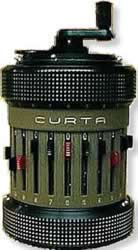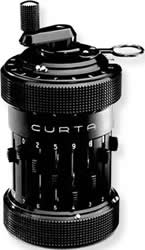Introduction
Over the years rumors were heard that Mr. Herzstark
secretly developed the Curta while imprisoned in a German concentration
camp. Apparently this is almost true. Herzstark was a prisoner at
Buchenwald but the camp leaders were aware of his work and encouraged
it. They apparently wanted to give the invention to the Fuehrer
as a victory gift at the end of the war! Herzstark was given a drawing
board and worked on the design day and night. The camp was liberated
in April, 1945 by the Americans. Herzstark survived as did his revolutionary
concept for a miniature calculator.

Description(1)
The Curta looks like a small metal pepper-mill or coffee
grinder. It is, in fact, a precision instrument which performs calculations
mechanically using no electric or electronic parts. I can best describe
the sensation of turning the crank on a Curta as being similar to
winding a fine 35mm camera. To the best of my knowledge it is the
smallest mechanical calculating machine ever built.
Although several prototypes were made earlier, the first production
began in April, 1947. The last Curta was made in November, 19?0 but
they were still sold until early 1973. By then, pocket electronic
calculators were selling for under $100 and a precision mechanical
instrument like the Curta could no longer compete.
The Curta II is slightly larger than the original Curta. It was first
produced in 1954 and has a larger numeric capacity than the Curta
I.
In 1949 only about 300 Curtas could be produced each month. By 1952,
production had increased to about 1,000 units per month. Over the
course of about 20 years approximately 80,000 of the Curta I and 60,000
of the Curta II were constructed.
Mr. Herzstark kept three prototypes in his home in Nendeln, Liechtenstein.
Upon his death in 1988 they were sold to a private collector.
Since the Curta is a precision instrument, it was sold with a protective
capsule or case. These are screw-top cylinders often with internal
padding.Some plastic capsules were made but these were found not to
be suitable so production was stopped and the metal cases again prevailed.Apparently
Prince Heinrich von Liechtenstein found the metal case to be too rigid
for a precision instrument so he had a special leather case crafted
for his Curta.
Specifications
| Codename: |
curta |
| CPU: |
|
| CPU speed |
|
| FPU: |
|
| motherboard RAM: |
|
| maximum RAM |
|
| number of sockets |
|
| minimum speed |
|
| ROM |
|
| L1 cache |
|
| L2 cache |
|
| data path |
|
| busspeed |
|
| SCSI |
|
| slots |
|
| Serial Ports |
|
| Parallel Ports |
|
| Floppy |
|
| HD |
|
| CD-ROM |
|
| Monitor |
|
| Sound Output |
|
| Sound Input |
|
| Ethernet |
|
| Type ID |
|
| power |
|
| Weight |
|
| Dimensions |
|
| Min System Software |
|
| Max System Software |
|
| OS
/ software |
|
| Input
devices |
|
| introduced |
|
| terminated |
|
| initial price |
|
Release history
|
 (2)
(2)![]()